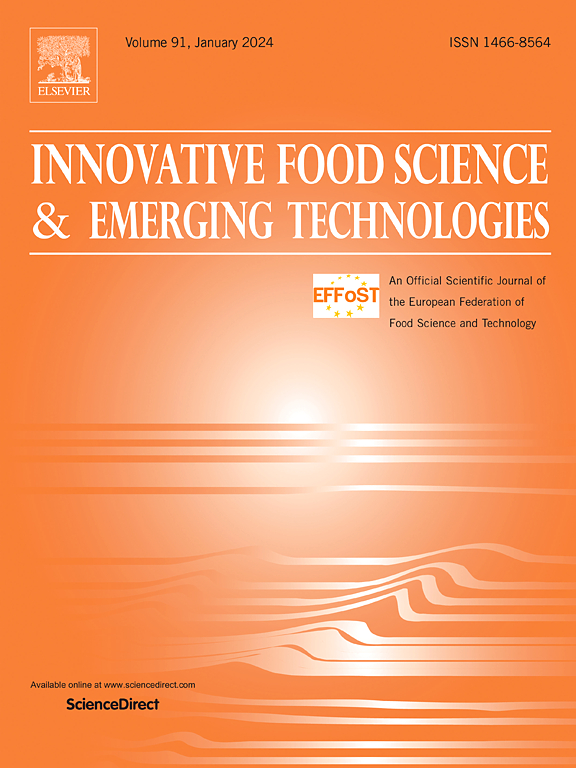Exploring of Cu-tannic acid laccase-mimicking nanozyme for effective degradation of aflatoxin B1
IF 6.8
1区 农林科学
Q1 FOOD SCIENCE & TECHNOLOGY
Innovative Food Science & Emerging Technologies
Pub Date : 2025-07-20
DOI:10.1016/j.ifset.2025.104123
引用次数: 0
Abstract
Aflatoxin B1 (AFB1) is a notorious mycotoxin known for its mutagenic and carcinogenic properties, representing a significant hazard to food safety. This study synthesized copper-tannic acid (CuTA) nanosheets with laccase-like activity through a straightforward self-association process involving copper and tannic acid. The CuTA nanozyme demonstrated the ability to oxidize AFB1, achieving a degradation rate of 95 % at an initial AFB1 concentration of 2 μg mL−1 at 37 °C within 24 h. UHPLC-HRMS analysis identified four degradation products catalyzed by CuTA nanozyme: M1 (C16H12O5), M2 (C17H12O7), M3 (C17H12O7) and M4 (C16H14O6). Three degradation pathways were proposed: 1) cleavage of the lactone ring in the coumarin moiety; 2) C3-hydroxylation leading to the formation of aflatoxin Q1; 3) epoxidation of the unsaturated carbons on the terminal furan ring, followed by epoxide removal and loss of the methoxy group from the side chain of the benzene ring. The combined in vitro and in vivo toxicity evaluations demonstrated the significant detoxification capability of the CuTA nanozyme on AFB1. Moreover, the application of CuTA nanozyme to degrade AFB1 in peanut oil resulted in a removal rate of 78 % within 9 h. Collectively, these findings underscore the considerable potential of utilizing laccase-mimicking CuTA nanozyme for the detoxification of AFB1.
铜单宁酸漆酶纳米酶降解黄曲霉毒素B1的研究
黄曲霉毒素B1 (AFB1)是一种臭名昭著的真菌毒素,以其致突变和致癌特性而闻名,对食品安全构成重大危害。本研究通过铜和单宁酸的直接自结合过程合成了具有漆酶样活性的铜单宁酸(CuTA)纳米片。在37℃条件下,当AFB1初始浓度为2 μg mL−1时,在24 h内,CuTA纳米酶的降解率可达95%。UHPLC-HRMS分析发现,CuTA纳米酶催化的4种降解产物分别为M1 (C16H12O5)、M2 (C17H12O7)、M3 (C17H12O7)和M4 (C16H14O6)。提出了三种降解途径:1)香豆素部分内酯环的裂解;2) c3 -羟基化导致黄曲霉毒素Q1的形成;3)末端呋喃环上的不饱和碳的环氧化,接着是苯环侧链上的环氧化物的去除和甲氧基的损失。体外和体内毒性综合评价表明,CuTA纳米酶对AFB1具有显著的解毒能力。此外,应用CuTA纳米酶降解花生油中的AFB1,在9小时内的去除率达到78%。总的来说,这些发现强调了利用漆酶模拟CuTA纳米酶解毒AFB1的巨大潜力。
本文章由计算机程序翻译,如有差异,请以英文原文为准。
求助全文
约1分钟内获得全文
求助全文
来源期刊
CiteScore
12.00
自引率
6.10%
发文量
259
审稿时长
25 days
期刊介绍:
Innovative Food Science and Emerging Technologies (IFSET) aims to provide the highest quality original contributions and few, mainly upon invitation, reviews on and highly innovative developments in food science and emerging food process technologies. The significance of the results either for the science community or for industrial R&D groups must be specified. Papers submitted must be of highest scientific quality and only those advancing current scientific knowledge and understanding or with technical relevance will be considered.

 求助内容:
求助内容: 应助结果提醒方式:
应助结果提醒方式:


